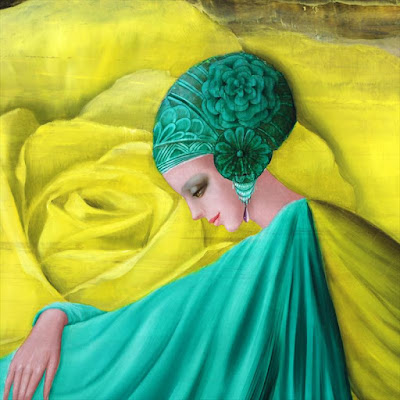Phillipe Auge's paintings strike us from the start by their size, purity, refined elegance and the predominant role held by women. At first sight, one realizes that this man could truly have worked in the world of fashion because of the care he devotes to producing particular effects with the dresses he puts on them which would not have seemed out of place in a fashion show.And then, when one takes a serious look at his biograhphy, one discovers that he did indeed work in haute couture, and, what is more, in Italy. He created materials for the greatest designers. He then lived in this particular universe where women inspired him with his most beautiful sets of clothes, his most marvellous and exuberant costumes. Phillipe Auge, who then went back to his paintings and paintbrushes, pursued this daydream of exquisite, slender and gentle youg women he clad with the most beautiful outfits.
About his most personal style, one could say that it has been influences or inspired by the masterpieces of the Italian Renaissance: the silhouettes, the elongates faces with almond green eyes, the fairy-fingered hands, the neat, tidy hairstyles, the small, thin feet recall the women of these ancient times, as they have come down to us through the paintings of Bellini, Bronzino or Caravaggio, their gestures are measured, their poses sensual and somewhat shy, self-effacing and full of wisdom.
From the Italian Renaissane, he may also have retained the harmony of rich, silky colours often enhanced with a washing of gold, the modelling, the art of draping, and a certain way of associating this omnipresent feminity with the flowers and the well-ripened fruit. One can almost still remember the taste of the fragance.
From the Italian Renaissane, he may also have retained the harmony of rich, silky colours often enhanced with a washing of gold, the modelling, the art of draping, and a certain way of associating this omnipresent feminity with the flowers and the well-ripened fruit. One can almost still remember the taste of the fragance.
Phillipe Auge does not place these women in rich, luxurious caskets. Much to the contrary, he plays with the contrast between an abstract, bare, timeless setting which is remarkable essentially for the harmony and calm it creates around the characters, and which brings out all the more sharply the beauty and elegance of his models. This emptiness, this free space around the women represented also remind us, in a certain way, of Chinese, Japanese or Korean painting.His eventful life between France and Italy, between the high society whom he portrayed in Rome and the theatre for which he created sets and costumes, between the haute couture workshops bustling like beehives and the silence of his own workshop where he found refuge away from any intrusion of the world, to paint in solitude and contemplation, ended very recently, in the same way as Caravage put an end to his: on a beah, left by a wave on the shore.His paintings remain as marvellous testimonies of his love of women, beauty and life.(picassomio.com)








No comments:
Post a Comment